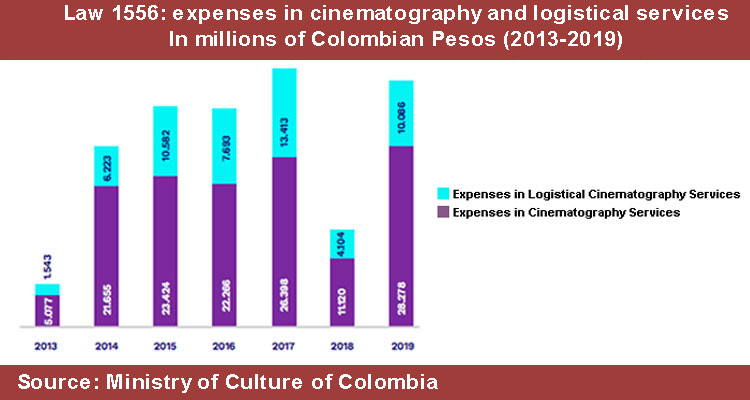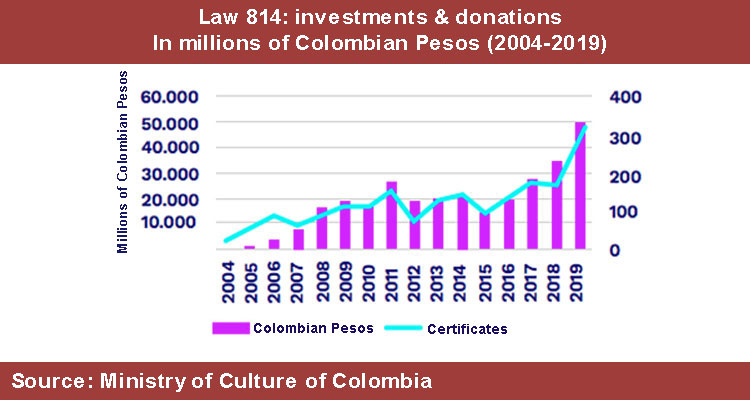Special Report
Ministry of Culture of Colombia: decentralization, incentives and audiovisual diversity

Jaime Tenorio, director of Audiovisual, Cinema and Interactive Media, Ministry of Culture
Colombia is an audiovisual benchmark in Latin America because of its prominent role that the local companies are taking in the international market, and for the clear strategy of the public sector through the promotion of its “Orange Economy”, which is bringing huge opportunities in this South American country and worldwide. Prensario analyzes the enhanced role of the Ministry of Culture in the promotion, new incentives and programs, and the commitment to a greater number of audiovisual voices.
According to the e-book «Orange Economy: Innovations that you did not know were from Latin America and the Caribbean» (June 2017) published by the Inter-American Development Bank (IADB), the Cultural and Creative Industries generated 1.9 million jobs in Latin America and the Caribbean, and revenues of USD 124 billions in 2015. The concept has been prominent for some years in Latin America, defined as a set of activities that in a chained manner allow ideas to be transformed into cultural goods and services, the value of which is determined by their intellectual property content.
Colombia, through its president Iván Duque, who has written and highlighted “Orange Economy” in several occasions, is clearly a regional reference. The country is preparing in 2021 to continue strengthening that competitive advantage, announcing new tax incentives for film and television, and reinforcing its attractiveness to receive audiovisual investments. And there the Ministry of Culture has a key role, led by Felipe Buitrago Restrepo, who has merged the Direction of Cinematography and the Direction of Communications to attend in an integral, transversal and convergent way the development of the audiovisual, sound, cinematographic and media ecosystem interactive maps of the country.
‘With these two offices integrated, added to the incentives and programs, we hope to have a greater diversity of voices and point of views of the country’s creators, decentralize production, improve circulation and access, and address the challenges of the 21st century in an increasingly digital and global environment’, highlights Jaime Tenorio, director of Audiovisual, Cinema and Interactive Media of the Ministry.
In recent years, the transversal incentives for the cultural sector designed by the Vice Ministry of Creativity and the Orange Economy also benefit the audiovisual ecosystem. Heading this strategy is Adriana Padilla Leal, who was appointed at the beginning of the year. Tenorio enumerates three calls from the Ministry: ‘The one for income exemption for 7 years for companies of the sector; “CoCrea” that allows audiovisual projects to be presented, either for production, training and preservation of heritage; “Comparte lo que somos” that allows many agents of the culture sector benefit, and the “Reactivarte”.
The Colombian Government has designed a system of mechanisms, supports and incentives that have energized the entire sector, adding agents such as the National Film Council (CNACC), the Colombia Film Promotion Committee (CPFC), which is chaired by the Ministry of Commerce and accompanies the Ministry of Culture, and other departmental and district offices.

Tenorio considered the public sector as a ‘motor of transformation’ since Law 814 (Film Law) from 2003, which created the Fund for Cinematographic Development (FDC), managed by the National Council of Arts and Culture in Cinematography and chaired by the Ministry of Culture, and tax incentives for investors and donors in film projects. ‘The FDC makes an annual call for the delivery of resources and the tax incentive consists of a deduction of 165% in income tax’, he indicates.
Almost 10 years later, Law 1556 (Colombia Filming Law), expanded in light of the current National Development Plan, created the Colombia Film Fund (FFC) that offers a return of 40% of the expenditure made in Colombia in audiovisual services and 20 % of return of the expense made in logistics services. Decree 474 of 2020, which extends Law 1556, prolonged its validity to 10 years, included other audiovisual formats in addition to film and created the Certificate of Audiovisual Investment in Colombia (CINA), a title value of 35% of the investment amount destined to the realization of non-national audiovisual works in Colombia; it is transferable in the stock market to be applied to the declarations and payment of self-withholdings of income tax’.
Tenorio: ‘To access to the two incentives of this Law, a minimum expenditure of USD 475,000 is required, filming or post-production can be carried out totally or partially, and the hiring of natural persons and Colombian companies to carry out the projects. It includes movies, series, music videos, video games, short web content and advertising: national and foreign projects can be presented to the FFC, but CINA is aimed at international producers. In both cases, the entire supply chain of goods and services for production benefits, there is an exchange of knowledge and employment and qualification of professionals and technicians in the sector’.
These normative instruments and others have made possible the strengthening of production, the qualification of professionals in the sector, a considerable increase in national works and the diversification of the commercial and alternative exhibition circuit. Tenorio underlines other factors: ‘Wide diversity of locations and natural settings between cities, beaches, jungles, modern and colonial architecture, which have been the location of more than 40 international projects, enabling processes of specialization and qualification of talents, as well as the chain of services’.
Among the challenges, he mentions strengthening the human resources: training of technical and artistic teams in a greater diversity of regions, increasing the levels of bilingualism and specializations in certain trades and departments, promoting the creation of regional film commissions that help, among other objectives, to facilitate procedures to carry out the filming. ‘With the resources that international producers allocate for the administration and monitoring of CINA, we can invest in resources for qualification processes for workers and managers of the audiovisual ecosystem’, he adds.

During the pandemic, the Colombian audiovisual sector was ‘hardly hit’ both by the closure of theaters and by the interruption in production: ‘The FDC delivered 129 incentives by competition for USD 2.6 million and 103 automatic stimuli for almost USD 110,000. The Directorate of Audiovisuals, Cinema and Interactive Media certified 30 projects and 117 certificates were issued for USD 5 millions of investments and donations in cinematographic projects. Under Law 1556, the CPFC approved 17 projects that will allow the investment of USD 82 million dollars and the creation of 1,987 direct jobs’, said Tenorio.
They were joined by the Programa Ibermedia with which USD 463,361 was awarded to 12 Colombian projects and the National Stimulus Program with almost USD 1 million. In coordination with the ICT Ministry, USD 1.1 million were delivered to support the production of digital content through the “Crea Digital” call. 522 cultural projects for USD 127.2 million were submitted to the “CoCrea” call. ‘In 2021 we will know which projects will benefit and how many belong to the audiovisual sector. In total for the sector, from the ICT Ministry, incentives for USD 6.8 million were offered,’ he said.
Training is another key element for growth: ‘We continue to design and implement an audiovisual policy in Colombia that allows us to draw up a roadmap for strengthening the audiovisual ecosystem, promoting decentralization, representativeness, participation and diversity in our country. In coordination with the Ministry of National Education, we will start a national transmedia literacy plan that allows us to strengthen children and adolescents as creators, as well as give them tools to have critical and reflective views on audiovisual content, also to promote filmmakers audiovisuals that produce works aimed at these audiences, and that involve traditional audiovisual narratives, sound and interactive and transmedia’.
And with the National Learning Service (SENA), initiatives will be implemented aimed at increasing the levels of audiovisual training in the different regions of Colombia. ‘This year, the films and series approved in 2020 will begin to be produced that will benefit CINA within the framework of Law 1556, and the approval of large productions made by important platforms and channels of the international market is expected, but of which we still cannot disclose information for confidentiality issues’, he explains.
Lastly, Tenorio speaks on Retina Latina, the initiative of the audiovisual authorities of Bolivia, Ecuador, Mexico, Peru, Uruguay and Colombia, which celebrates five years. Coordinated by Colombia, it has allowed better access to Latin American cinema through this public digital platform to watch Latin American cinema for free. In its implementation it had the support of the IDB, and more recently with resources from the International Fund for Cultural Diversity of UNESCO for the development of its application for mobile devices and its training component.
‘It currently offers a sample of classic films that account for the diversity of narratives and authorial views of Latin America. The programming will be accompanied by activities and virtual meetings, between agents of the Latin American audiovisual industry and the public to reflect and discuss the challenges that It implies responding to the demands of audiences for Latin American cinema, co-productions, the Latin American diaspora, as well as networking, greater visibility and positioning our productions in a virtual environment where it has expanded exponentially’, Tenorio concludes.

